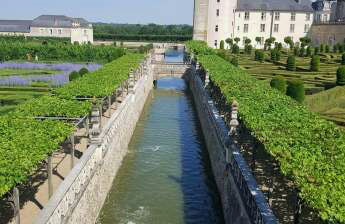If you are planning a trip to the Loire Valley, it is impossible to miss a visit to Chateau de Villandry. It is one of the last Renaissance castles built in the region and was founded by Jean le Breton, a finance minister under Francois I.
This magnificent renaissance jewel is ranked among the best French heritage properties and its formal gardens are an exquisite treat in any season. The garden experts have spent a lot of time to recreate the gardens to reflect what it was like in the Renaissance era.
1. The Gardens
A must see when visiting the Loire Valley, Villandry’s magnificent gardens will take your breath away. These are a true gem of the region and have become renowned worldwide for their incredible beauty.
The gardens are a great place to spend an hour or two, wandering around and enjoying the beauty of them. The gardeners here are fully committed to sustainable and organic gardening.
The original gardens at Villandry were designed by Jean Le Breton, who served as the Finance Minister under Francis I and was enamoured with Italian Renaissance gardening. He created these ornamental masterpieces at his new chateau.
2. The Interior
The interiors of Chateau de Villandry are a real treat for any visitor to this stunning Loire Valley property. Visitors can explore the neoclassical decor and beautiful furniture that fills many of the rooms, as well as valuable art collections.
A spectacular paint and gilt Moorish ceiling from Toledo, along with a collection of 17th-century Spanish paintings, are just two of the things that make the interiors so special. There are also a number of family portraits on the wall, warm interiors and lush carpeting throughout.
During the 18th century, the castle was redecorated to meet modern standards of comfort. Michel-Ange de Castellane, a prominent member of the Provencal nobility from Provence, had the interiors renovated and he installed wood panelling to insulate the spacious rooms and help them stay cool.
It was the gardens that brought a lot of attention to this chateau and today they are considered one of the best in the world. The six gardens here are laid out on a series of terraces, each with its own identity and aesthetic principles.
3. The Food
The food at Chateau de Villandry is another reason why so many visitors flock to this Loire Valley castle. You'll find a variety of restaurants in the town nearby and also a restaurant overlooking the castle.
The gardens at Chateau de Villandry are the most spectacular you'll find in the entire Loire Valley. They're a beautiful blend of Renaissance and Neoclassical styles that are sure to impress.
Jean Le Breton, the Finance Minister of King Francis I, transformed the old fortress into a stately French chateau in 1536. He had an interest in gardening and this was reflected in the design of the garden.
The garden at Villandry is a mixture of classical and mystical gardens with an array of beautiful terraces. The symmetrical square plots make up a multi-coloured checkboard when viewed from above and is one of the most impressive sights you will ever see.
4. The Views
If you’re looking for a truly enchanting castle near Tours, then you should definitely consider visiting Chateau de Villandry. Although it was never a royal castle, there’s still a majesty and elegance about it that is sure to impress.
The estate was created during the Renaissance amidst a breathtaking setting. The massive stone keep was conserved and the three main buildings were built around it to create a horseshoe shape.
It is one of the most architecturally impressive and beautiful of the Loire’s Renaissance castles. Unlike most, it isn’t dominated by medieval influences like towers and turrets. Instead, it has a more modern French Renaissance look, reminiscent of Anet and Fontainebleau.
The gardens at Villandry are considered to be the best in the entire region, and they’re certainly a must-visit when you visit the castle. They’re officially a ‘Jardin Remarquable’ according to the Committee for Parks and Gardens in France, and they’re a true delight at all times of the year.
